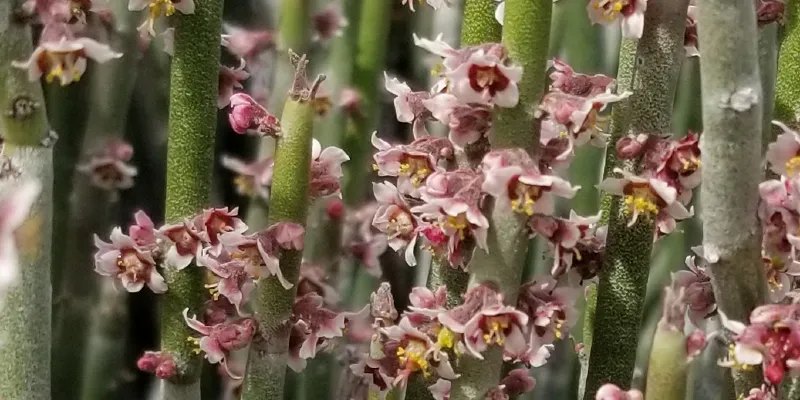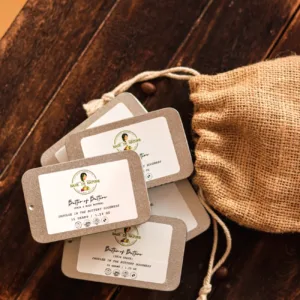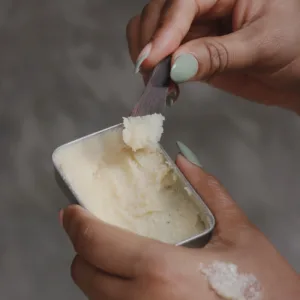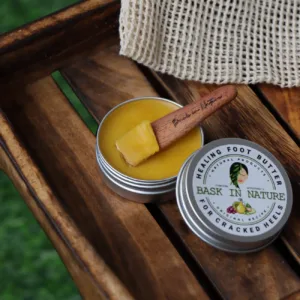
Candelilla
Synonyms: none
Scientific Name: Euphorbia antisyphillitica, Euphorbia cerifera, Pedilanthus pavonis
Family: Euphorbiaceae (Spurge Family)
Habitat
Semideserts of southern California, Arizona, southwestern Texas, northern Mexico and parts of Central and South America.
Constituents
Hydrocarbons (approx. 50 %, C29-C33), esters, free fatty acids, free fatty alcohols and resins.
Description
The candelilla shrubs Euphorbia antisyphilitica, Euphorbia cerifera and Pedilanthus pavonis have developed a clever tactic to protect themselves against the heat of their native Mexico. Their grey-green unbranched stems and sparse leaves are coated with a hard wax – candelilla wax – which prevents evaporation and protects the plants from environmental influences. The plants perform photosynthesis mainly through the stems. The common feature of all members of the spurge family is their milky sap or latex. The flowers which grow on the thin stems in spring and autumn are worth a closer look: what appears to be a single flower is in fact the combination of a female flower at the center surrounded by several male flowers. These individual flowers are reduced to ovary and filaments. Botanists call this type of inflorescence a cyathium. The white leaves which surround the cyathium are so-called bracts or nectaries which appear like petals on account of their color.
Uses
Candelilla wax has a very high melting point and a firm texture. It has a shiny appearance, binds oils well, adheres well, feels pleasant on the skin, smells of beeswax when hot and is even edible. It is therefore an ideal ingredient for skin care, particularly for lipsticks which are given greater stability by the wax.
In the food industry this versatile wax is used for coating jelly beans, nuts, coffee beans, snacks and chocolates to stop them from sticking together. Candelilla wax makes industrially produced bakery products brown nicely and stops them from sticking. It is added to chewing gum to give it the right consistency. Citrus fruits, apples, melons or pears stay fresh longer under a layer of candelilla wax. They are then referred to as waxed.
Paper and cardboard coating materials, hotmelt adhesives, shoe creams, writing ink, furniture polish, erasers, carbon paper, coloring materials and candles: the list of products in which candelilla wax is used to provide shine, a good texture or protection against moisture and sticking seems endless. It is even used for coating rubber and phonograph records.
Interesting Facts
The word candelilla comes from the Spanish and means little candle or little light. The name aptly describes the shape of the shrub’s long, thin, bare stems. Also, the wax used to be used for making candles. The Euphorbiaceae are named after Euphorbus, the doctor of King Jaba of Mauretania, 54 B.C. Euphorbus is said to have been the first person to use the sap of the plants of the spurge family for medicinal purposes. The epithet antisyphilitica reflects the folk lore that this plant could be used to treat syphilis.
Close to the Mexico-Texas border, along the mesa’s western edge, archaeologists found a series of red and yellow rock paintings between 1500 and 4000 years old which were drawn with a mixture of mineral pigments and candelilla wax.
In Higueras, a Mexican village in the province of Nuevo León, the Candelilla Festival takes place on 12th December. During the festival the bishop of Monterrey blesses the piles of candelilla bushes with holy water. Then the village elders set fire to the piles. Without fuel or paper the candelilla bushes quickly begin to blaze and within a few minutes everything has turned to ash. The villagers dance to traditional music and honor the remains of the burnt candelilla. This festival combines ancient customs of the indigenous Mexican population with Christian tradition.
The Plant in our Products
Bask in Nature’s products containing Ingredients from Candelilla Shrub :


Butter of Butters
₹685.00 – ₹1,265.00Price range: ₹685.00 through ₹1,265.00Rated 4.95 out of 519 reviews

Healing Foot Butter
₹345.00 – ₹625.00Price range: ₹345.00 through ₹625.00Rated 5.00 out of 511 reviews




